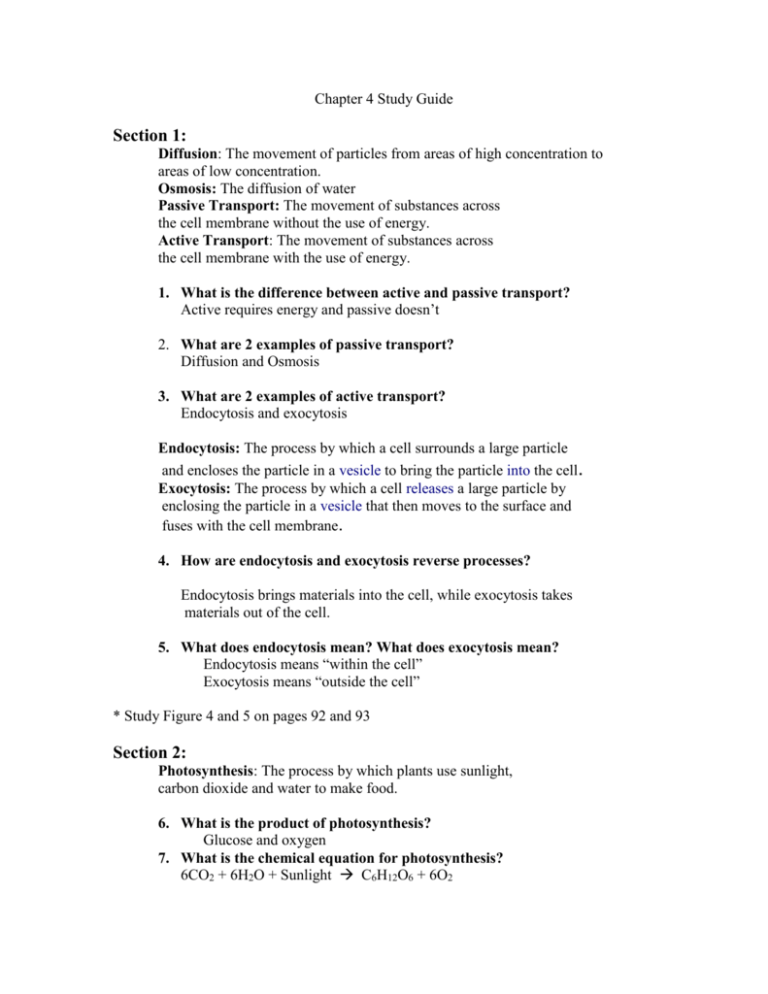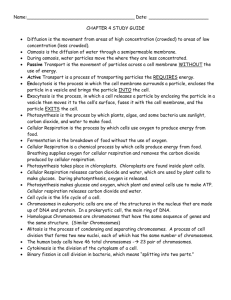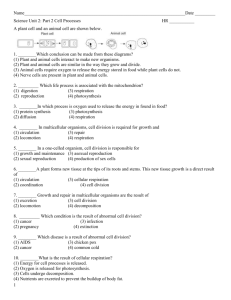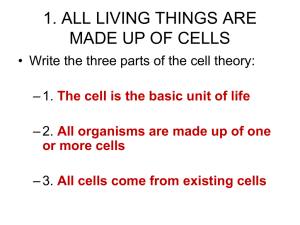Chapter 4 Study Guide
advertisement

Chapter 4 Study Guide Section 1: Diffusion: The movement of particles from areas of high concentration to areas of low concentration. Osmosis: The diffusion of water Passive Transport: The movement of substances across the cell membrane without the use of energy. Active Transport: The movement of substances across the cell membrane with the use of energy. 1. What is the difference between active and passive transport? Active requires energy and passive doesn’t 2. What are 2 examples of passive transport? Diffusion and Osmosis 3. What are 2 examples of active transport? Endocytosis and exocytosis Endocytosis: The process by which a cell surrounds a large particle and encloses the particle in a vesicle to bring the particle into the cell. Exocytosis: The process by which a cell releases a large particle by enclosing the particle in a vesicle that then moves to the surface and fuses with the cell membrane. 4. How are endocytosis and exocytosis reverse processes? Endocytosis brings materials into the cell, while exocytosis takes materials out of the cell. 5. What does endocytosis mean? What does exocytosis mean? Endocytosis means “within the cell” Exocytosis means “outside the cell” * Study Figure 4 and 5 on pages 92 and 93 Section 2: Photosynthesis: The process by which plants use sunlight, carbon dioxide and water to make food. 6. What is the product of photosynthesis? Glucose and oxygen 7. What is the chemical equation for photosynthesis? 6CO2 + 6H2O + Sunlight C6H12O6 + 6O2 Cellular Respiration: The process by which cells use oxygen to produce energy from food. 8. What is the chemical equation for cellular respiration? C6H12O6 + 6O2 6CO2 + 6H2O + Energy 9. Explain how photosynthesis and cellular respiration are related. One can’t happen without the other. Photosynthesis needs the products made in cellular respiration and cellular respiration needs the products made in photosynthesis. 10. In which organelle does photosynthesis occur? In which organelle does cellular respiration occur? Photosynthesis occurs in the chloroplast. Cellular respiration occurs in the mitochondria Fermentation: The breakdown of food without the use of oxygen. 11. Fermentation in muscle cells produces: Lactic Acid * Study the diagram on page 96 Section 3: . Chromosome: One of the structures in the nucleus that are made up of DNA and proteins Homologous chromosomes: Chromosomes that have the same structure and the same sequence of genes 12. What does copying chromosomes prior to cell division ensure? That each cell will get a copy of the chromosomes 13. What are the 3 stages of the cell cycle? Interphase, Mitosis and cytokinesis 14. What are the 4 phases of mitosis? Explain each phase. Phase 1 – Chromosomes condense into rodlike structures Phase 2 – Chromatids line up in the center of the cell Phase 3 – Chromosomes get pulled to opposite sides of the cell Phase 4 – The nuclear membrane reforms around the chromosomes 15. What type of cell forms a cell plate? Plant cell 16. In which stage do chromosomes get copied? Interphase 17. What is cytokinesis? The splitting of the cytoplasm *Study the diagram on pages 100-101








